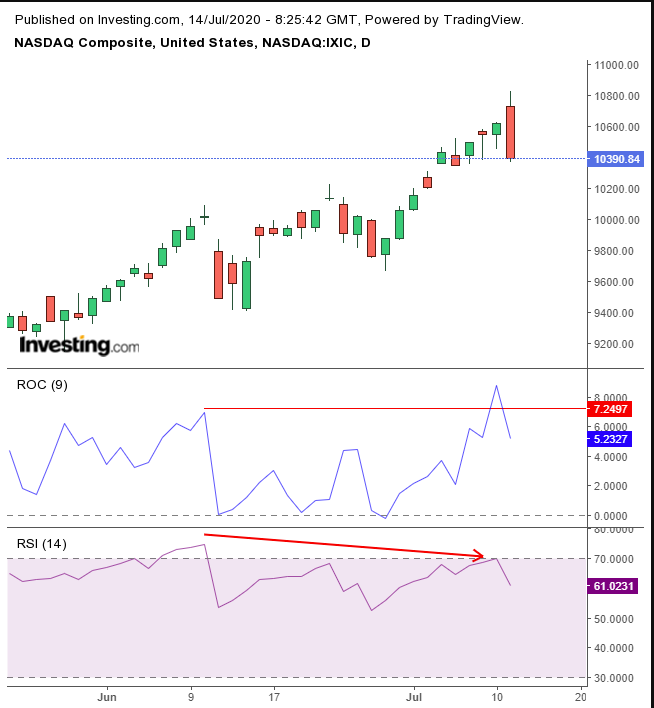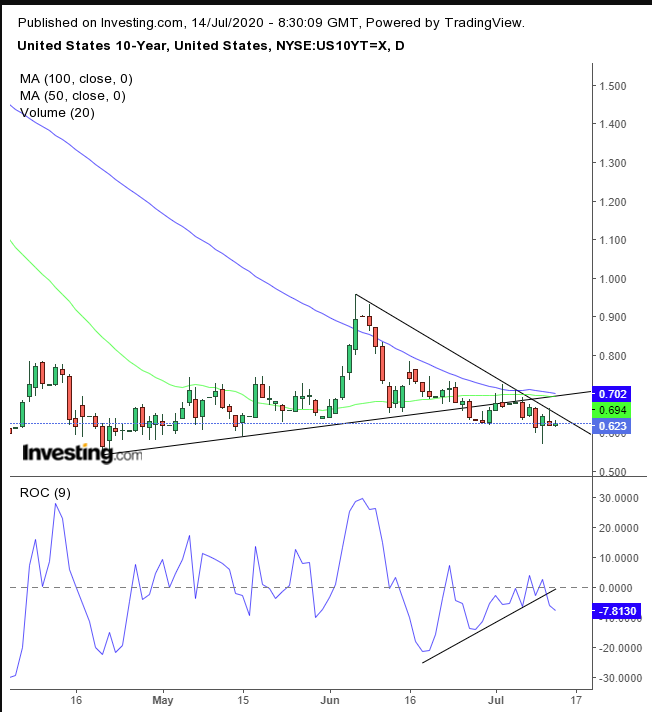- Global stocks fall on California lockdown, despite positive China data
- Gold pressed lower by stronger dollar
- Oil falls below $40 ahead of EIA report
Key Events
US futures for the S&P 500, Dow Jones, NASDAQ and Russell 2000 fluctuated on Tuesday, while European shares tanked. Renewed worries about the second California shutdown weighed on markets after the US's most populous state announced yesterday it was reacting to a spike in COVID-19 cases. Investors are concerned this return to lockdowns will offset optimism driven by a string of better-than-expected economic data and hopes for a positive earnings season.
The dollar strengthened, pressuring gold. Oil remains below $40.
Global Financial Affairs
Though all four contracts on the major US indices opened higher, they were dragged down at the start of the European session. However, at time of writing all are trading higher.
The Stoxx Europe 600 Index was down 1.4%, paring a 1.9% initial drop that erased nearly two days of gains.
Asian indices all finished in the red. They'd gained earlier this morning when China’s trade data for June beat estimates. Exports rose 0.5%, while imports jumped 2.7% YoY. But ongoing US-China tensions—this time a shift in Washington policy toward Beijing's maritime claims in the South China Sea—dragged regional markets lower.
Hong Kong’s Hang Seng suffered the worst selloff, (-1.14%). It opened 1.4% lower, after the financial hub joined a global trend to reimpose containment measures in effort to slow down the raging pandemic. South Korea’s KOSPI outperformed, (-0.1%), closing only marginally lower, as the country added only 33 new coronavirus cases today, demonstrating sharply slowing momentum from Monday’s 62 confirmed cases and Sunday’s 44. Health officials still warned of a continued rise in cluster infections and imported cases.
From time to time we point out ironies in the market narrative, here's today's incongruity: a selloff in Asia and Europe over the lockdown in California, while US futures bulls push back.
There's also an argument to be made that investors are “becoming immune to deterioration in relationship between US and China.” However, this morning's drop seems to have proven that wrong. Of course, we can’t be sure what’s really in the minds of investors when it comes to in short-term moves. We are simply projecting the narrative.
On Wall Street during Monday's session, most US shares declined, after reaching the highest levels intraday since the panic-induced March coronavirus selloff. The Dow Jones Industrial Average was the only major index that managed to remain in the green, even if just barely, (+0.04%). The NASDAQ Composite underperformed, (-2.1%), after posting another new all-time high.

The tech-heavy index produced a powerful engulfing bearish pattern, that enveloped almost 5 candles. Both the ROC and RIC momentum indicators provided negative divergences, suggesting that price got ahead of itself.
Yields, including for the US 10-year Treasury note, wavered, but seemed to gain a foothold, trimming some of yesterday’s dip.

Rates are still under considerable pressure, as investors increase their Treasury positions, pushing yields below an uptrend line since April 21 with momentum dissipating. Some investors, in search of higher, albeit riskier, yields, have been lured by non-US sovereign bonds.
The dollar strengthened.

However, it remained under considerable pressure after completing a rising flag, supported by a death cross, a bearish MACD cross and falling momentum, as shown on the ROC and RSI.
The stronger dollar weighed on gold.

The precious metal was pushed below its rising channel. While we remain bullish, there's still the possibility of a profit-taking pullback—with the weakening price trend and momentum—before the precious metal attempts to beat its current record high. Of particular note, when denominated in other currencies, gold looks even more bullish.
Oil fell back below $40 a barrel, ahead of this week's EIA inventories report, to the lowest since June 30.

Still, WTI seemed to find support by an uptrend line since May 22, after failing to keep up with the steeper uptrend line since April 28. The MACD suggests the price trend is weakening, alongside falling momentum, as shown by the RSI, suggesting the current, flatter uptrend, will fail as well.
From a fundamental perspective, oil markets are wobbling as traders await OPEC's next decision on Wednesday regarding whether to temper output cuts.
Up Ahead
- Q2 2020 earnings season officially kicks off before US markets open today, when the big US banks including JPMorgan (NYSE:JPM), Bank of America (NYSE:BAC), Wells Fargo (NYSE:WFC), Goldman Sachs (NYSE:GS) and Citigroup (NYSE:C) report.
- China releases second-quarter GDP on Thursday as well as key economic indicators for June.
- The European Central Bank meets to set monetary policy on Thursday, with President Christine Lagarde holding a virtual press conference afterward.
Market Moves
Stocks
- Futures on the S&P 500 Index climbed 0.3%.
- The Stoxx Europe 600 Index declined 1.4%.
- The MSCI Asia Pacific Index dipped 0.8%.
- The MSCI Emerging Markets Index slumped 1.1%.
Currencies
- The Dollar Index advanced 0.1%.
- The euro slipped 0.1% to $1.1336.
- The British pound fell 0.2% to $1.2527.
- The Japanese yen was little changed at 107.28 per dollar.
- The offshore yuan weakened 0.3% to 7.019 per dollar
Bonds
- The yield on 10-year Treasuries climbed less than one basis point to 0.62%.
- The yield on two-year Treasuries increased less than one basis point to 0.15%.
- Germany’s 10-year yield fell two basis points to -0.43%.
- Britain’s 10-year yield fell three basis points to 0.16%.
- Japan’s 10-year yield declined one basis point to 0.033%.
Commodities
- West Texas Intermediate crude fell 0.7% to $39.33 a barrel.
- Brent crude dipped 0.5% to $41.97 a barrel.
- Gold weakened 0.1% to $1,800.27 an ounce.
